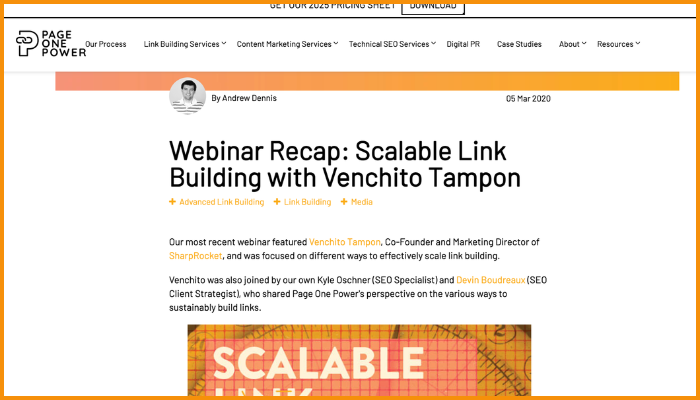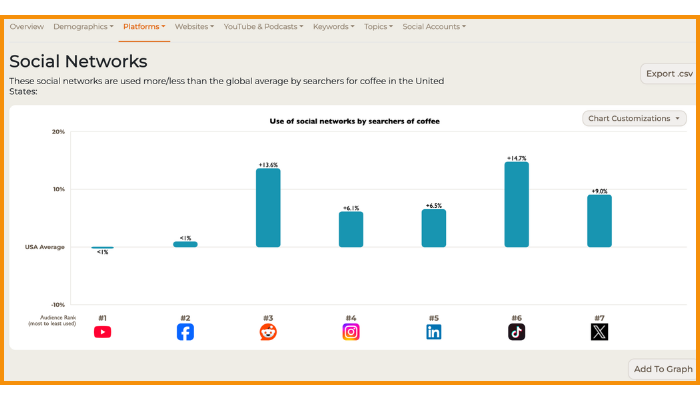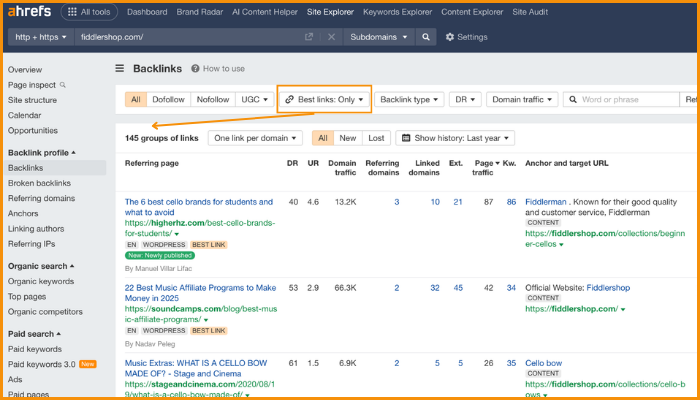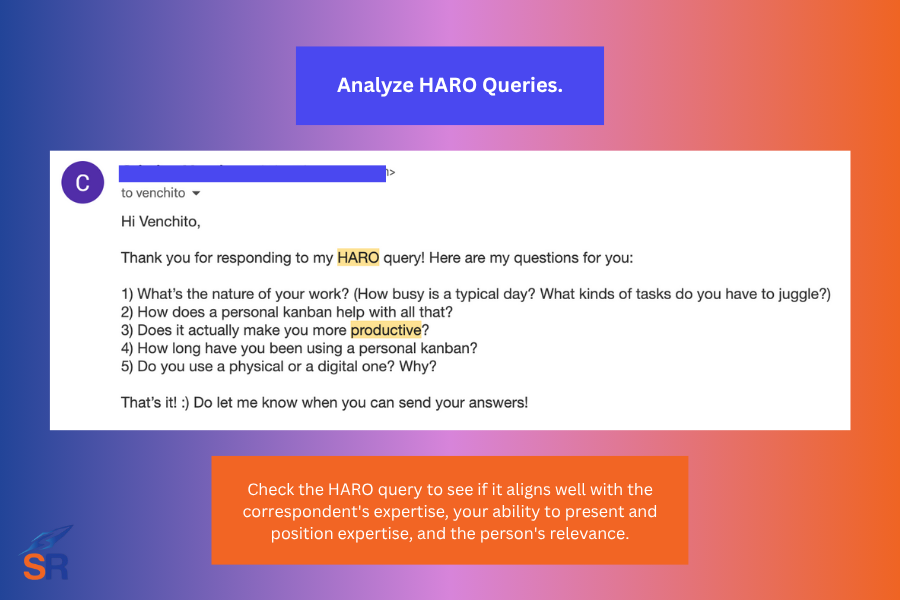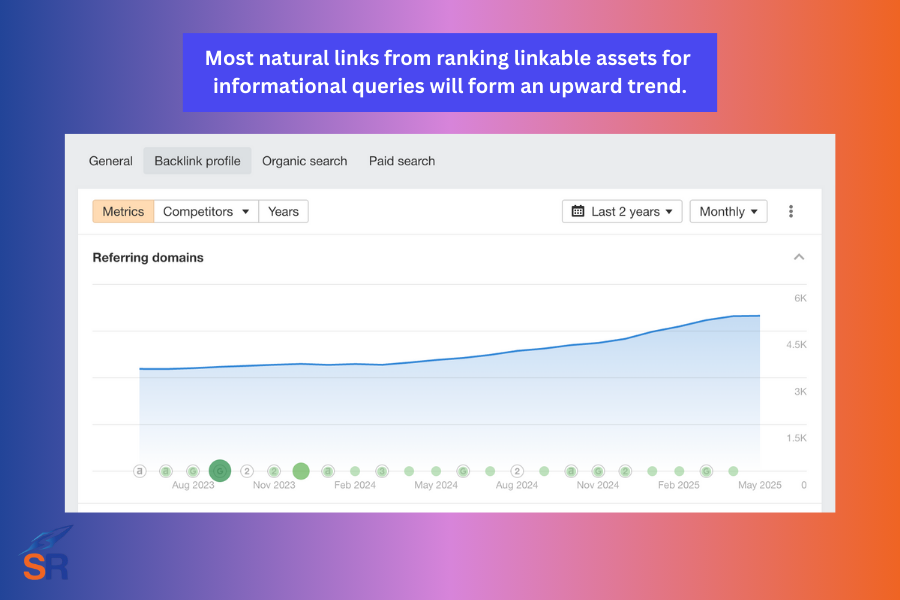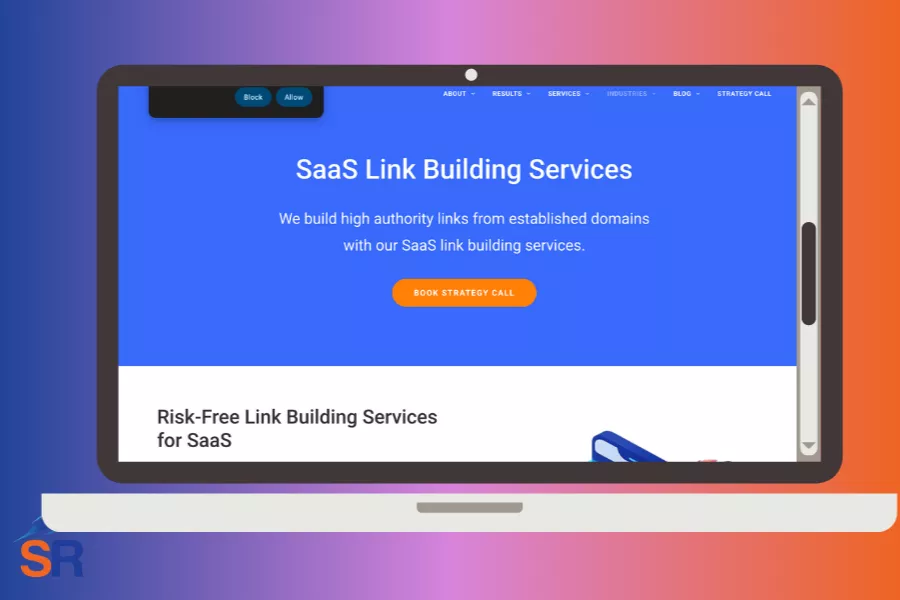Link building plan is the operational blueprint that turns your link building strategy into measurable outcomes, timelines, and specific actions required to acquire backlinks for your site – helping you achieve your campaign objectives.
Having a documented plan will help your team navigate their tasks and maintain focus, maximizing resources to scale your link building campaign and producing quality output that surpasses what your competitors can do.
A couple of reasons why link building plan is a must for in-house SEOs, agencies, and enterprise teams:
- It centralizes efforts on things that matter to the business – given that there are many routes you can take in link building, the links you get or earn must ultimately contribute to the overall business objectives.
- It pushes you to achieve as many quick wins as possible, especially for SEO agencies that operate on a pay-per-link model – knowing you’ll have guaranteed links at the end of each month eases a lot of stress and ensures you’re delivering on agreed-upon expectations.
- It helps you persuade internal stakeholders or clients to invest more budget in link acquisition, as they can see the value of the work right on paper – your link building plan.
- It measures your actions and adjusts elements of your tactics to create higher-quality links – without a plan, you wouldn’t know where your campaign is failing.
Bring these compelling reasons to your link building plan.
Contents
ToggleHaving a Strong Base
The success of any link building plan can be traced back to the SEO strength of the website and its internal capabilities to obtain or get backlinks.
Part of the link building plan is to ensure that the pillars of SEO are in place, so that links will have a more significant impact on their destination pages and the overall site’s link equity and authority.
I won’t delve into all fundamentals of SEO, but here are the ones you should prioritize:
- Crawlable and indexed pages by search engines (especially the most important pages and the ones you want to build links to).
- Produce helpful content assets you can later use as a value proposition in outreach or direct destination pages for links (from which you can include internal links to pages you want to rank for).
- Well-optimized pages (meta tags, headers, internal links, etc.) – for less competitive keywords, applying this basic optimization can help you show up in a good position on Google’s SERPs.
- Optimize the page speed of target pages – as you only have a few seconds to impress your link prospects when you send content for link requests.
Apply basic optimization before any link building efforts to get the maximum value from your link building campaign.
How to Create a Link Building Plan
Now, let’s go over how to create a link building plan:
1. Understand The Business, Target Audience, and Link History
Knowing your target audience (whether for your own site or your clients) is crucial to creating a link building plan that meets the exact needs of your target customers.
Given that it’s possible to hit both the business goals and ranking objectives of your client when you acquire links from websites where your target customers are also engaging in (“hitting two birds with one stone”).
The best way to learn more about your audience is by asking the right questions and gathering the correct information directly from your organization (for in-house SEO specialists) or from the client (for agency SEO).
Create a questionnaire you can send over to your client or internal stakeholders.
Here’s a sample list of important questions:
- Who is your ideal customer? What are their demographics, interests, and online behaviors?
- What distinguishes your product or service from competitors? What value do you offer that others don’t?
- Who are your main competitors in your industry?
- Have you previously engaged in link building or SEO efforts? What were the outcomes of those initiatives?
- Do you have existing relationships with influencers or distributors? How have these relationships been utilized in your marketing efforts?
- Are there any other details or insights about your business that could inform our link building strategy?
With these questions, you’ll have a better understanding of the business, its target audience, and any previous link building campaigns (the ones that worked and that didn’t).
Having all this historical data enables you to manage client expectations and set campaign objectives that are more realistic to achieve, which leads to the next step in creating a link building plan.
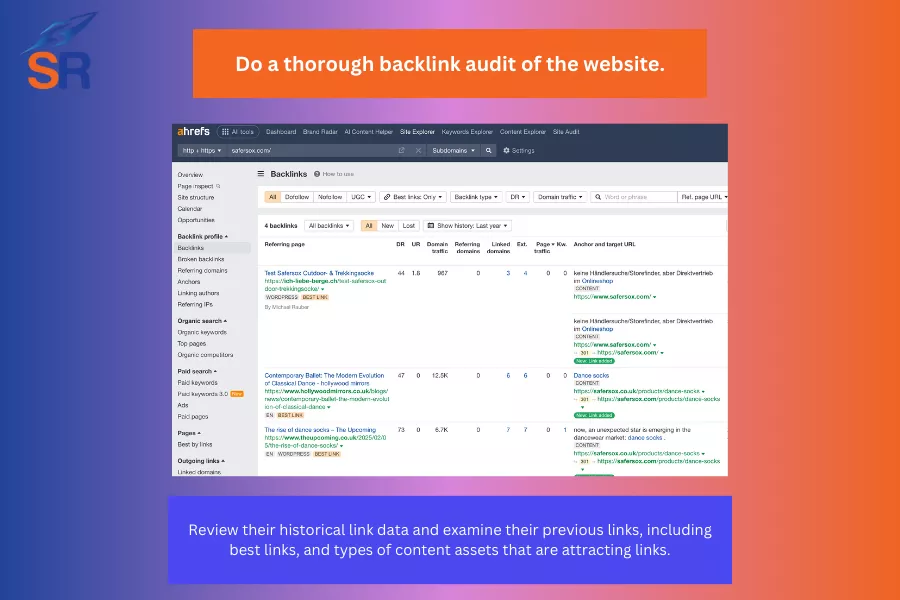
Pro Tip: One of our standard practices as a link building agency when working with clients is conducting a quick analysis of their backlink profile during the proposal stage – to review their historical link data and examine their previous links. It includes assessing:
- Top referring pages to see which pages are driving the most referral traffic – view this best in their Google Analytics data or Ahrefs’ Top Referring Pages. These are the types of backlinks you need to get more of for your site.
- Types of content assets that are attracting passive links from publishers who are citing their work as additional references – build more of these assets and create a “flywheel” effect, and expect to have incoming links every month.
2. Set Your Goals and Campaign Objectives
Goal setting is what actually gives direction to your link building campaign.
And the most important goals for a link building campaign in achieving a holistic organic marketing campaign are the following:
- Improve the site’s domain authority (DR) to have a competing ability to rank for its target keywords (both for commercial and informational terms)
- Generate more demand for the business by acquiring customers directly from referring pages and landing pages that rank well for their target keywords.
- Enhance brand visibility and recognition by being more visible for non-branded searches and/or increasing branded searches.
- Amplify the reach of specific content assets to gain more visibility, engagement, and opportunities to passively earn links by ranking for queries that publishers search for to find more resources.
Next, set campaign objectives based on these goals and your understanding of the business, its history, and the target audience, as outlined in step 1 of this link building plan guide.
These objectives are more actionable, realistic, and easy to understand, which you can include as the initial section of your document to send to your client or internal stakeholders.
Before I show you how to create these campaign objectives, let me first walk you through where we get data for setting campaign objectives:
Through Link Gap Analysis
What is link gap analysis?
Link gap analysis is the process of identifying the differences between your website’s backlink profile and those of your competitors. It sets a clear benchmark for the number of links you need to build to specific pages of your site and helps you spot areas where your competitors may have missed or overlooked opportunities.
Link gap analysis aims to estimate the number of high-quality backlinks to target each month that meet specific metrics, such as sites with an Ahrefs Domain Rating (DR) of 30 or higher. This becomes part of your campaign objectives, focusing on both the volume and value of links you desire to pursue for your site.
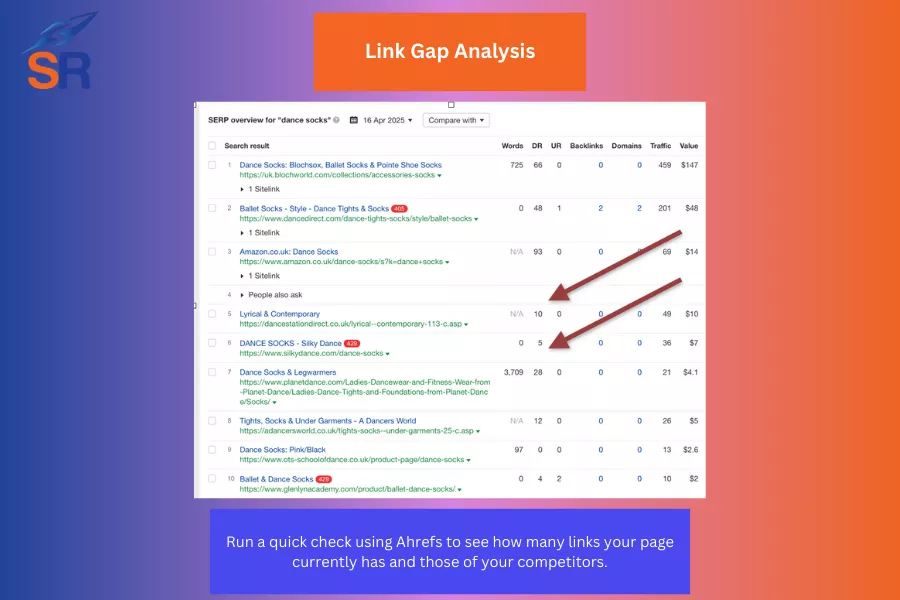
Start your analysis by selecting the page you want to rank for and identifying the top-ranking competitors for the page’s target keyword. Ignore big competitors (i.e., big eCom brands like Amazon) and look for ones within your range of site authority.
Run a quick check using Ahrefs to see how many links your page currently has and those of your competitors.
Filter the links that/are:
- Come from sites with DR30+.
- Has traffic of at least 1K
- Within the specified target country/audience (if you’re targeting local/international)
- In-content
- Dofollow
The remaining links from filtering are what you consider, conservatively, to be the number of high-quality backlinks to your page. Do the same for your top-ranking page competitors.
Then calculate the difference between these two numbers, which will give you the link gap count you should aim for.
For more detailed steps on how to do link gap analysis, check out our guide on competitor link analysis.
Define Campaign Objectives
Campaign objectives are the more granular part of your link building plan, as they deal specifically with what you want to achieve in your link development campaign that will impact your site’s branding, SEO, and conversion.
Here are examples of campaign objectives:
Site Rankings
Obviously, the goal of link building is to improve target pages for both head terms and long-tail keywords. This is especially true for the key buyer terms your business or client wants to rank for.
Example of Campaign Objective: The main objective of this link building campaign is to rank for dance socks (and other keyword variants like “contemporary socks”, “ballet socks”, and “dancing socks”) in the UK.
Pro Tip:
As a link building consultant, I typically suggest achieving quick wins – keywords that are more achievable to rank given the current site’s authority and its existing backlink profile.
And part of the SEO quick wins is utilizing internal linking to help important pages increase their keyword positions by adding internal links from other related pages.
Brand Sentiment and Reputation
Beyond rankings, you want to acquire links that will help improve your target users’ perception of your brand – as this could also positively affect how you appear on AI platforms.
Example of Campaign Objective: We also want to improve the brand’s sentiments and reputation for this website [SiteName] by only getting links from link sources you want your brand to be associated with, and focusing on the type of links and link placement on the page where you’re likely to get clicks.
Link Velocity
One of the common mistakes I’ve seen SEO specialists make is aggressively building backlinks in the first few months without considering the site’s current domain authority and potential risks associated with sudden spikes in link velocity.
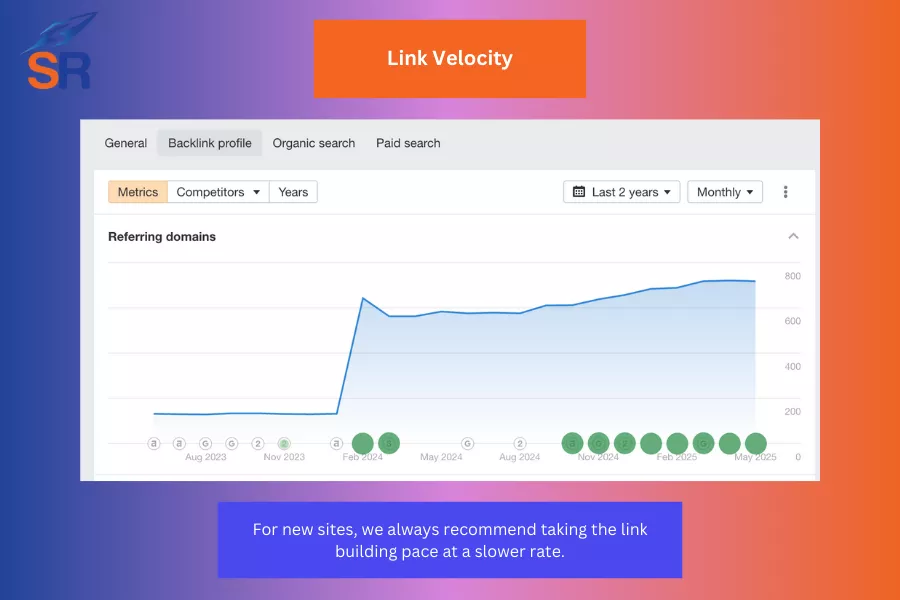
Unnatural link velocity can actually raise red flags in Google’s algorithm, putting your site at risk of manual actions or algorithmic penalties, especially for new domains or sites with limited initial authority.
Example of Campaign Objective: Given the site’s authority, DR5, we will focus on acquiring 10-15 contextual backlinks per month that align with the site’s existing domain authority. This pace helps us ensure steady, sustainable growth of the site’s domain authority while staying within safe thresholds.
Then, we gradually increase the pace as the site authority and organic traffic continue to grow (potentially from 15 to 25 target links).
Pro Tip:
For new sites, we always recommend taking the link building pace at a slower rate, with an average of 5 to 8 links per month (with 8 being the maximum).
We want to see the impact of these few links on their direct page. If there is a significant effect, we either increase the links pointing to the page until it reaches the highest position possible (the top 3 positions) or consider allocating other links to the site’s other essential pages that may need a boost in rankings.
Link Diversity
The types of pages you point your backlinks to matter, especially in the early stage of the link building campaign – when you are still proving that the links acquired actually improve the page’s search performance.
Our link diversity approach depends on the current site authority and its existing backlink profile.
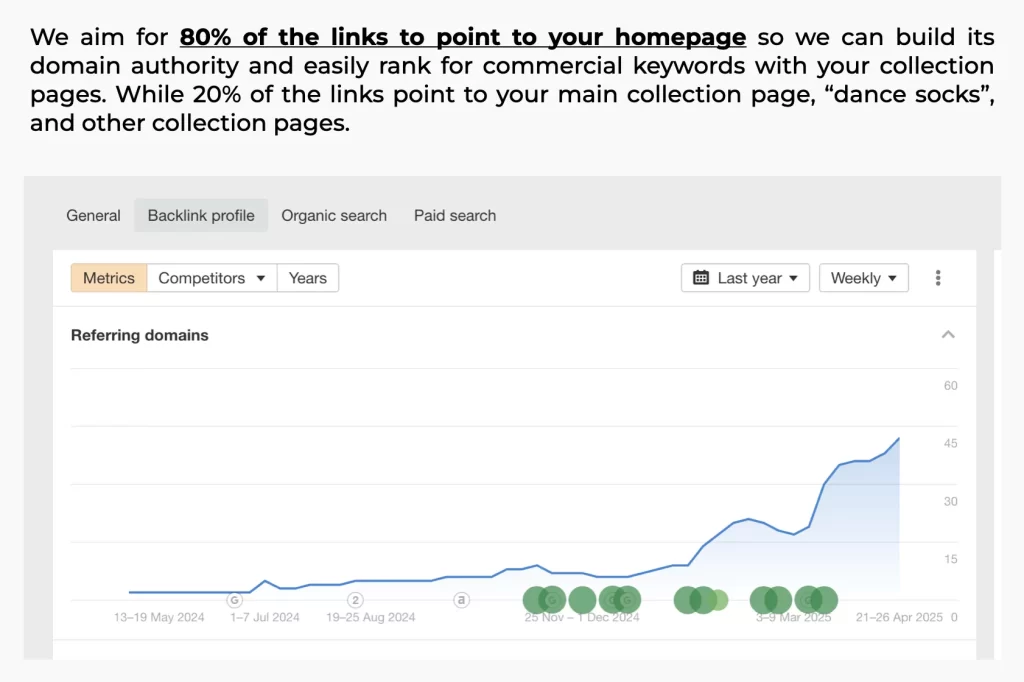
For new sites, we often recommend building the majority of the links (80%) to the homepage to boost its ranking power, while allocating 20% to the site’s main product category or service pages – as it’ll be much easier to contest for head terms when the website has a higher domain authority.
Then, as the site’s domain authority grows, we will focus on building more links to product and service pages and blog content.
3. Identifying Potential Link Partners
Prospecting the right link opportunities is often the determining success factor of a link building campaign, as the value of a link depends on the types of people and sites that would link to you.
Use your link building campaign’s objectives to direct your team to the right types of link sources. For instance, if one of your campaign objectives is to increase positive brand sentiment and improve your brand reputation, working only with publishers and entities you want your brand to associate with is essential.
Examples of these are:
- Potential brand partners (vendors, suppliers, future brand advocates, etc.).
- Trusted and authoritative voices in your space (authors, thought leaders, personalities, and in-house experts).
- Content creators with targeted communities (to absorb their social media followers and turn them into actual visitors or customers for your site).
Here are our best link prospecting methods, regardless of the industry of our clients:
Competitor Link Analysis
I wrote a detailed guide on how to do competitor analysis, but let me give you a couple of tips here:
Always start by reverse engineering competitors you can compete with – this means avoiding trusted brands that Google already favors (e.g., Amazon and Walmart).
Instead, target ranking competitors within your site’s authority range. If you have a DR30 site, focus on competitor link analysis for websites with a domain rating (DR) between 20 and 60.
Another reason for choosing sites you have chances of competing is you want to be realistic as much as possible – the backlinks you get from reverse engineering mid-level competitors are easier to replicate given their existing resources and value proposition – since they aren’t too far ahead of you in terms of authority, branding, and SEO budget.
Filter the links based on scalable link building strategies.
There are several link building strategies in SEO – both basic and advanced, where you can almost guarantee the conversion rate when doing outreach campaigns using those strategies.
Focusing on the type of links that a specific strategy targets can make the process easier when picking potential link targets through competitor backlink analysis.
For example, you can quickly check resource pages on the list by filtering words like “links” or “resources” and see if your competitor has acquired any links from resource pages. Or, if you want to look for “where to buy” pages for eCommerce, you can filter the list by “where to buy”, “store list”, and “retailer”.
Leverage Link Intersect
You can automate competitor link analysis using Ahrefs’ Link Intersect feature – it shows you the links pointing to your competitors but not to your site, giving you quick access to the list (instead of manually reverse-engineering competitors individually).
Link Search on the Web
Go beyond the usual competitor backlink analysis route and start looking for potential link sources that are relevant to your industry.
At SharpRocket, we’re big fans of Ahrefs’ Content Explorer. All of our team members are accustomed to using it to explore different advanced search filters, keywords, and variations, which helps us get the best results for potential relevant linking pages.
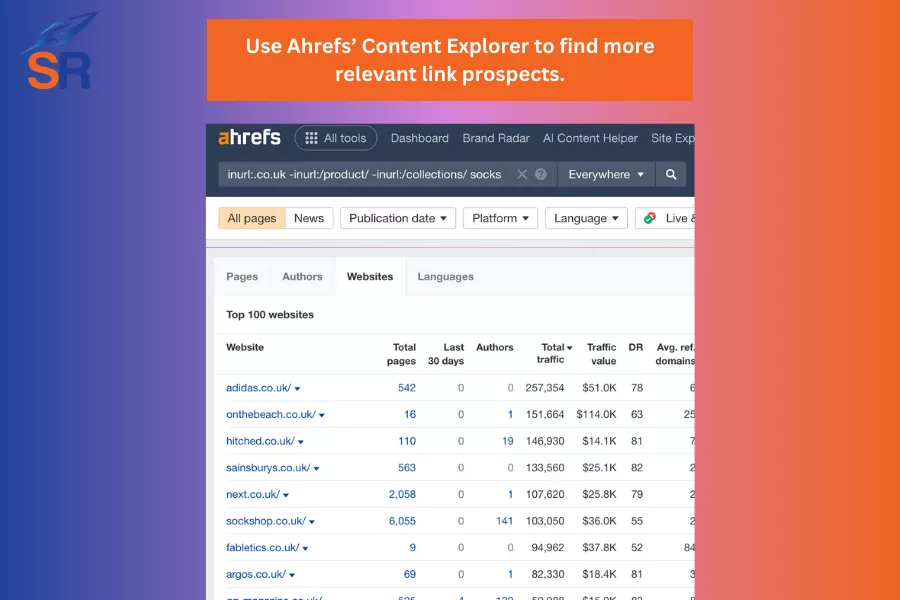
Target Active Authors
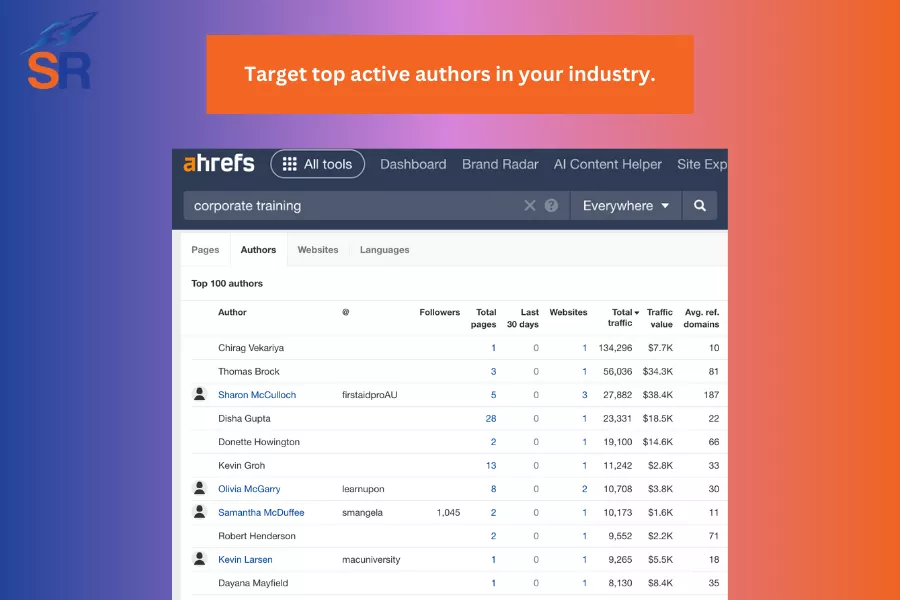
On top of exclusively prospecting for websites, you can also directly look for the top active authors in your industry.
The best part about this approach is that you can leverage these authors’ existing networks and relationships, especially on the websites where they have already contributed content.
With many high-end, authoritative publishers with strict editorial guidelines — where they only accept experts and experienced contributors — you can penetrate these sites by contacting authors who already have published content there.
Brand Partners
Besides the typical link prospecting methods most SEO specialists use, i.e., competitor link analysis and manual or automated link search, spotting brand partners as part of your link prospecting list is still an effective way to build your site’s reputation and topical authority.
The best links will come from domains that elevate your site’s branding and reputation—these are link partners that target the same audience you want to engage.
The common mistake I’ve seen in-house SEO specialists make is ignoring sites with lower domain authority (i.e., those with an Ahrefs DR 20 or less), even if they are obviously topically or locally relevant to their brands.
Pro Tip: If you’re not in the hustle of delivering guaranteed links every month (i.e., monthly link deliverables for link building agencies), you can go after these weaker brands but with higher brand and niche relevance, seeing that they have the potential to grow in the future in terms of authority and given the legitimacy and sustainability of the business they’re in.
Here are some examples of low-authority but brand-relevant sites:
- New websites of legitimate vendors and suppliers in your industry
- Upcoming authors with targeted niche communities
- Social media influencers with unoptimized websites for SEO (but with assets you can leverage for content amplification and more brand discovery through collaboration and other co-marketing opportunities).
Client Block List (or “Do Not Contact” List)
One standard practice we integrate into our link prospecting process is creating a client blocklist, which is basically a list of all the websites we or our client don’t want to reach out to.
Having this initial client blocklist as part of your link prospecting process can help eliminate inefficiencies in outreach. You don’t need to spend time reaching out and following up with prospects from whom you don’t want to get links.
A few examples of these websites are:
- Competitors that offer similar products or services.
- Affiliates and existing partners requested by the client for non-contact
- Referring domains already linked to the client’s site – as the client wants all new backlinks to come from domains that weren’t previously linked to their site.
4. Create Linkable Content Assets
I’ve discussed this part extensively in my guide on creating conversion-oriented, linkable assets.
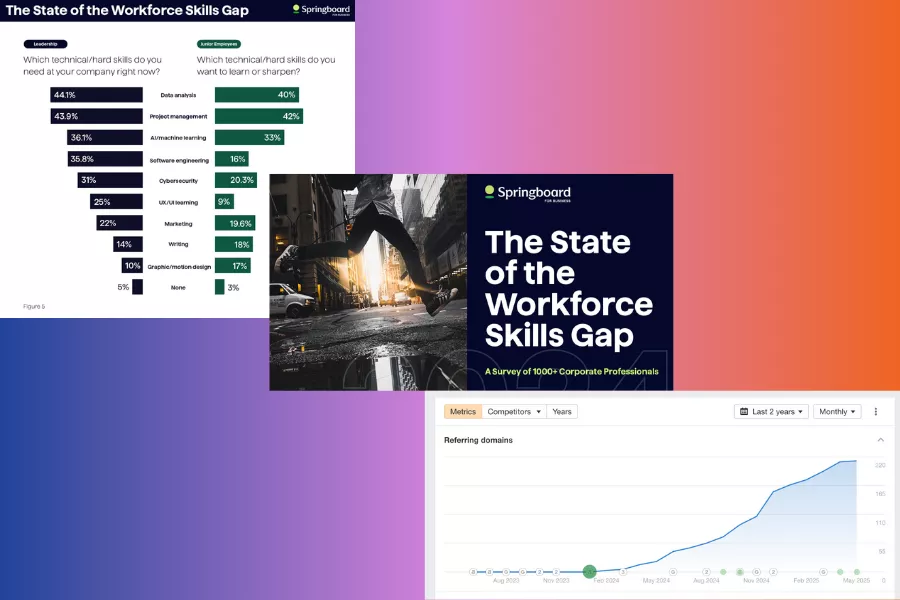
But here are some actionable tips:
- Tie the linkable asset to the problem you want to solve (i.e., Franchising 101 and 102 guides for my target coffee franchisees).
- Publish first-party data or insights.
- Identify the step before the solution
- Offer zero-friction tools or techniques that don’t require emails to access (e.g., editable templates, checklists, scripts, and visual frameworks)
- Apply unique expertise to sales pages (e.g., use case scenarios, in-house scoring systems, internal testing protocols, etc.).
There are two approaches to leveraging linkable assets:
- Develop and use them as a direct value proposition for outreach, so that target websites link to these pages.
- Distribute the exact linkable content asset to selected link partners (i.e., choosing authoritative websites with a larger audience, email list, or social media following).
5. Manage Outreach Campaigns
Outreach campaigns are still effective in acquiring high-quality backlinks, but the approach has evolved over the years. This is because publishers and webmasters have detected the same patterns and outreach angles that most SEO specialists use to get links from them.
And since then, they have ignored the majority of pitches that offer the same intent or purpose in emails.
I’ve covered different angles and tactics in my guide on link building outreach, but let me repeat a couple of actionable tips here:
- Product-comparison add-on outreach.
- Content refresh and upgrade.
- Reverse outreach
- Stats-driven outreach
- Keep initial messages short. Brevity in outreach makes it easier to send semi-personalized mass emails while forcing your outreach team to focus on the value that matters most to your target link prospects (removing fluff and unnecessary introductions in emails).
- Educate publishers by using simple, non-technical terms, persuading them of the value of your content pitch – i.e., it helps increase their search traffic as your content targets a relevant keyword, which can rank and earn organic traffic.
- Stay updated with industry happenings and suggest more unique or highly specialized topics for guest posts not yet covered on their blogs.
6. Monitor Backlinks and Do Quality Assurance
The next step in your link-building plan is to monitor new backlinks to your site. These will come from webmasters you have reached out to using manual outreach or from publishers who cite your content as a reference in their articles.
You can manually check each domain in your outreach list for backlink monitoring or automate the process using link building tools like Ahrefs’ Alerts and Mangools.

Part of good link monitoring is having quality assurance (QA) on the links placed, as one benefit of doing so is making early remedies for recently acquired links that don’t meet the necessary criteria.
Review each live backlink based on:
- Target pages – the backlink must point to the target page of your campaign.
- Quality of content – conduct a second quality review of the content distributed to link partners (i.e., check if the guest post is well-optimized for SEO).
- Link placement – verify that the backlink has been placed (does the publisher actually link to you, or do they simply mention you without a link?) and is correctly positioned in the relevant section of the content.
- Link attribution (dofollow or no-follow attributes)
Checking the quality of backlinks will help you take remedial efforts, such as requesting to add links for unlinked mentions – a much better approach than doing outreach months after your brand has been mentioned.
7. Prepare a Link Report
Preparing a link report is the final phase of the link building plan, which is part of a monthly SEO strategy for in-house SEO specialists and SEO agencies offering link building services.
The practice of reporting live backlinks to internal stakeholders or clients has numerous benefits for both parties – SEO practitioners and those receiving the report, including:
- Increases buy-in for stakeholders and clients, as they can see the better value of every link acquired and how these links affect the site’s entire SEO performance, branding, and organic revenue.
- Persuades clients and internal managers/directors to increase their link building budgets to tackle more competitive link building campaigns for high-value keywords.
- Forces in-house SEO teams to innovate by either A/B testing outreach copies or angles to increase link conversions, or trying new link building strategies from other observed industries where those strategies have proven effective.
Now, let’s move on to preparing a link report.
A monthly link-building report isn’t as glamorous as what other SEO bloggers try to portray. It is basically a collection of all the critical work you’ve done and future activities you want to pursue for next month.
Here’s our recommended list of things you should definitely include in link building reports:
- URLs of published links
- Date when links were added (could be based on when the page was indexed, whether it’s a new page, or the time of notification by the publisher/webmaster in emails).
- Link metrics in columns (Ahrefs’ DR, site traffic, etc). – also include average DR for all links acquired
- Anchor text used in backlinks
- URL of backlinks’ target pages
- Link building tactics used
- In-progress notes (i.e., waiting for approval for content created by your team)
- Next steps (i.e., continuous link prospecting and outreach, to publish specific linkable assets, or execute a new link-building strategy)
Plan For Link Building Success
The only way to guarantee success in link building is to plan and execute relentlessly – nothing else beats a well-thought-out link building plan.
Learn about our link building services and contact our experienced strategists to help build more backlinks to your website.
Written By
Venchito Tampon
CEO and Co-Founder at SharpRocket, a link building agency. With a decade of experience, Venchito has a proven track record of leading hundreds of successful SEO (link builidng) campaigns across competitive industries like finance, B2B, legal, and SaaS. His expert advice as a link building expert has been featured in renowned publications such as Semrush, Ahrefs, Huffington Post and Forbes. He is also an international SEO spoken and has delivered talks in SEO Zraz, Asia Pacific Affiliate Summit in Singapore, and Search Marketing Summit in Sydney, Australia. Check out his other business - Hills & Valleys Cafe.
Reviewed By

Sef Gojo Cruz
COO at SharpRocket, overseeing end-to-end operations, from crafting link building strategies to leading high-performing teams. Previously led SEO initiatives at Workhouse, a digital agency in Australia, and Keymedia, a real estate media company based in New Zealand.
How our LINK BUILDING AGENCY in UK builds 250 links/mo consistently using Predictable Link Building Methodology™…
- Using a SIMPLE and PROVEN system
- Using a SCALABLE strategy
- No private blog networks
- No creepy outreach emails

